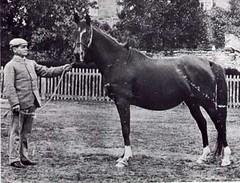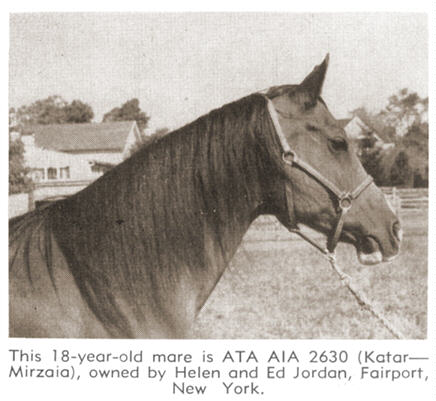Lost asil tail females: Dajania
It seems almost impossible to believe that this line has been lost to asil breeding in the tail female. Where have all the Kuhaylan Da’jani gone? Dajania‘s was the second-most important line in Crabbet breeding, which is one of the preeminent components of today’s mainstream Arabian horse breeding. True, there has never been as many mares from the Dajania tail female as there has been from the Rodania line at any given point in time, but that makes this line’s contribution to the breed all the more spectacular.
Dajania’s daughter Nefisa (x Hadban) produced 21 foals at Crabbet. Of the mares, Narguileh (x Mesaoud) and Nasra (x Daoud) were the most prepotent. A look at Al Khamsa’s online Roster allows one to trace the evolution of Nefisa’s Al Khamsa eligible progeny over the first half of the twentieth century. The record is impressive, but but most of the contribution to asil breeding is through males: Nadir, Narkise, *Nasik, Rustnar, Najib, *Nafia, Nusi, Adonis, etc. The last Dajania Al-Khamsa eligible tail female descendent is Nadirat (Rizvan x Nusara), born in 1927, when most of us were not born yet..
![]()
![]()

That said, Al Khamsa doesn’t accept Nureddin II (by Rijm x Narguileh, another Da’jani and Nasik’s full brother) nor his offspring (and I am not sure I want to get into THAT discussion here). But lets say it did, for the sake of argument.. and this gets us to Jordan’s Fa-saia (by Faserouf x Ata Aia by Katar, born in 1962), which is where it starts to hurt.
Ata Aia (Katar x Mirzaia by Mirzam) was bred by the US Remounts from 100% Crabbet bloodlines. She seems to have been a really typey mare (picture below), and so was her daughter Jordans Fa-saia according to Joe Ferriss who saw her. Fa-saia brought Babson bloodlines into the picture, and so did her son, Serrison (x Serris), born in 1975, and probably the last asil Kuhaylan Da’jani of the Dajania line.. Joe told me of a last ditch effort to do something with Jordan’s Fa-saia, but things didn’t work out. How sad..

I know there were Al Khamsa eligible tail-female descendants of Dajania after Nadirat, although they might not yet be in the Al Khamsa database. One is Nadirat’s 1946 daughter Aalastra, by Gulastra. And of course there was Nadirat’s famous 1935 daughter Aarah, by Ghadaf.
Nefisa is one of the most interesting of all the Crabbet broodmares, with her 21 live foals. Nine of these were fillies. Although Narghileh and Nasra were the two retained for breeding at Crabbet, and probably two of her best, the other fillies are worth a look too.
Nefisa’s first filly was Nahla 1889 (by Ashgar). The Blunts actually planned to retain her for breeding, but she died in the fall of her three-year-old year from overeating acorns in Crabbet Park.
Nefisa’s next filly was Nejiba 1892 (by Azrek). From her picture, this was a really dandy grey Azrek daughter. She did produce four foals at Crabbet, all colts. One died, one was sold to India, one to Scotland, and one was given to a nephew of Lady Anne’s who lived in Greece. Nejiba herself was given away at age 11 to the son of a longtime friend of Wilfrid Blunt’s.
Nefisa’s next filly was Narghileh 1895, marked “very fine” in the Crabbet records.
Narghileh did have two younger full sisters, Nawara 1902 and Ninawa 1904, both sold to South Africa in 1906. Nawara at least is the subject of commentary in Lady Anne Blunt’s journals, where she is noted as having faulty action and one that “should be got rid of.” So presumably Narghileh was the best of the three Nefisa fillies by Mesaoud.
Nefisa’s next filly was by Feysul and born in 1906, but she lived only a month.
Nefisa’s last three fillies were all by Daoud. Of these, the most famous is the first, Nasra 1908, who became one of the all-time great Crabbet broodmares.
The next was Nadima 1909, sold to Argentina at age four, where she founded a line of Arabian breeding.
Finally there was *Nueyra, Nefisa’s 21st and last foal, born when Nefisa was 27. Wilfrid Blunt sold *Nueyra to W.R. Brown in 1918. History has not been kind to *Nueyra. Her photographs are disappointing, and she was the animal in W.R. Brown’s large Crabbet imporatation that he liked least. However, nobody seems to take into account that this was the 21st foal out of a 27-year-old mare. By that time, Nefisa probably had a severely compromised uterus and not very good milk. In fact, Nefisa’s next-to-last foal, a colt by Daoud, is described in Crabbet records as “Beautiful colt. Died after 6 weeks; mare short of milk.” *Nueyra was probably lucky to have survived at all. Furthermore, *Nueyra was just two years old when World War I started. All of the Crabbet horses are known to have suffered from fodder shortages during the Great War.
Kuhaylan Da’jani Is the north of horses or Called Chamie horses
That’s right, it’s a strain from the Northern Arabian desert. It’s main breeders are the Shaykhs of the tribe of al-Juhaysh, a Zubaydi tribe in the area near al-Mawsil (Mossul) and Tall ‘Afar in Northern Iraq.
In Australia, we are required by law to provide DNA analysis for the AHSA’s data base. My mare came back as the strain we have been discussing. She has strong Crabbet lineages. Would that satisfy a Bedu?
Kerrie Davies
Hi, I believe i may have a 13th generation mare with direct descent direct from Da jania through Nefisa Nasra Nisreen Nisireh Kassa Khalasa Leila Amanda Roscilla Lurex Lynandra Park Shah jaanie, Liza